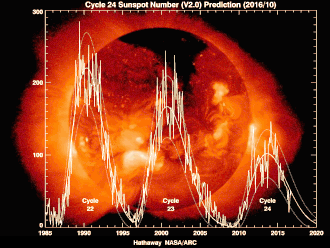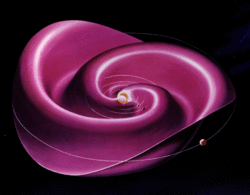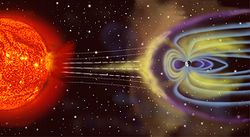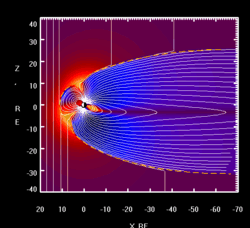Solar phenomena
This article has multiple issues. Please help improve it or discuss these issues on the talk page. (Learn how and when to remove these messages)
|

Solar phenomena are
These phenomena are believed to be generated by a helical dynamo, located near the center of the Sun's mass, which generates strong magnetic fields, as well as a chaotic dynamo, located near the surface, which generates smaller magnetic field fluctuations.[2] All solar fluctuations together are referred to as solar variation, producing space weather within the Sun's gravitational field.
Solar activity and related events have been recorded since the eighth century BCE. Throughout history, observation technology and methodology advanced, and in the 20th century, interest in astrophysics surged and many solar telescopes were constructed. The 1931 invention of the coronagraph allowed the corona to be studied in full daylight.
Sun

The Sun is a star located at the center of the Solar System. It is almost perfectly spherical and consists of hot plasma and magnetic fields.[3][4] It has a diameter of about 1,392,684 kilometres (865,374 mi),[5] around 109 times that of Earth, and its mass (1.989×1030 kilograms, approximately 330,000 times that of Earth) accounts for some 99.86% of the total mass of the Solar System.[6] Chemically, about three quarters of the Sun's mass consists of hydrogen, while the rest is mostly helium. The remaining 1.69% (equal to 5,600 times the mass of Earth) consists of heavier elements, including oxygen, carbon, neon and iron.[7]
The Sun formed about 4.567 billion
The Sun is a
The Earth's mean distance from the Sun is approximately 1
Solar cycle

Many solar phenomena change periodically over an average interval of about 11 years. This solar cycle affects
.The solar cycle also modulates the flux of short-wavelength solar radiation, from ultraviolet to X-ray and influences the frequency of solar flares, coronal mass ejections and other solar eruptive phenomena.
Types
| Part of a series of articles about |
| Heliophysics |
|---|
 |
Coronal mass ejections
A coronal mass ejection (CME) is a massive burst of
Coronal mass ejections often appear with other forms of solar activity, most notably
When a CME impacts the Earth's magnetosphere, it temporarily deforms the Earth's
Flares
A solar flare is a sudden flash of brightness observed over the Sun's surface or the
Solar flares strongly influence space weather near the Earth. They can produce streams of highly energetic particles in the solar wind, known as a
- A solar flare
-
On August 31, 2012, a long prominence/filament of solar material that had been hovering in the Sun's atmosphere, the corona, erupted out into space at 4:36 p.m. EDT.
-
Diagram of the magnetic-field structure of a solar flare and its origin, inferred to result from the deformation of such a magnetic structure linking the solar interior with the solar atmosphere up through thecorona.
-
A complete 2D-Image taken by STEREO (High Resolution)
Solar proton events

A solar proton event (SPE), or "proton storm", occurs when particles (mostly protons) emitted by the Sun become accelerated either close to the Sun during a flare or in interplanetary space by CME shocks. The events can include other nuclei such as helium ions and
Prominences
A prominence is a large, bright, gaseous feature extending outward from the
Prominence plasma is typically a hundred times cooler and denser than coronal plasma. A prominence forms over timescales of about an earthly day and may persist for weeks or months. Some prominences break apart and form CMEs.
A typical prominence extends over many thousands of kilometers; the largest on record was estimated at over 800,000 kilometres (500,000 mi) long [24] – roughly the solar radius.
When a prominence is viewed against the Sun instead of space, it appears darker than the background. This formation is called a solar filament.[24] It is possible for a projection to be both a filament and a prominence. Some prominences are so powerful that they eject matter at speeds ranging from 600 km/s to more than 1000 km/s. Other prominences form huge loops or arching columns of glowing gases over sunspots that can reach heights of hundreds of thousands of kilometers.[25]
Sunspots
Sunspots are relatively dark areas on the Sun's radiating 'surface' (photosphere) where intense magnetic activity inhibits convection and cools the Photosphere. Faculae are slightly brighter areas that form around sunspot groups as the flow of energy to the photosphere is re-established and both the normal flow and the sunspot-blocked energy elevate the radiating 'surface' temperature. Scientists began speculating on possible relationships between sunspots and solar luminosity in the 17th century.[26][27] Luminosity decreases caused by sunspots (generally < - 0.3%) are correlated with increases (generally < + 0.05%) caused both by faculae that are associated with active regions as well as the magnetically active 'bright network'.[28]
The net effect during periods of enhanced solar magnetic activity is increased radiant solar output because faculae are larger and persist longer than sunspots. Conversely, periods of lower solar magnetic activity and fewer sunspots (such as the Maunder Minimum) may correlate with times of lower irradiance.[29]
Sunspot activity has been measured using the
Sunspots usually appear as pairs with opposite magnetic polarity.[31] Detailed observations reveal patterns, in yearly minima and maxima and in relative location. As each cycle proceeds, the latitude of spots declines, from 30 to 45° to around 7° after the solar maximum. This latitudinal change follows Spörer's law.
For a sunspot to be visible to the human eye it must be about 50,000 km in diameter, covering 2,000,000,000 square kilometres (770,000,000 sq mi) or 700 millionths of the visible area. Over recent cycles, approximately 100 sunspots or compact sunspot groups are visible from Earth.[c][32]
Sunspots expand and contract as they move about and can travel at a few hundred meters per second when they first appear.
-
Spörer's law noted that at the start of an 11-year sunspot cycle, the spots appeared first at higher latitudes and later in progressively lower latitudes.
-
A report in the Daily Mail characterized sunspot 1302 as a "behemoth" unleashing huge solar flares.
-
Detail of the Sun's surface, analog photography with a 4" Refractor, yellow glass filter and foil filter ND 4, Observatory Großhadern, Munich
-
Detailed view of sunspot, 13 December 2006
Wind


The solar wind is a stream of plasma released from the Sun's upper atmosphere. It consists of mostly electrons and protons with energies usually between 1.5 and 10 keV. The stream of particles varies in density, temperature and speed over time and over solar longitude. These particles can escape the Sun's gravity because of their high energy.
The solar wind is divided into the slow solar wind and the fast solar wind. The slow solar wind has a velocity of about 400 kilometres per second (250 mi/s), a temperature of 2×105 K and a composition that is a close match to the corona. The fast solar wind has a typical velocity of 750 km/s, a temperature of 8×105 K and nearly matches the photosphere's.[33][34] The slow solar wind is twice as dense and more variable in intensity than the fast solar wind. The slow wind has a more complex structure, with turbulent regions and large-scale organization.[35][36]
Both the fast and slow solar winds can be interrupted by large, fast-moving bursts of plasma called interplanetary CMEs, or ICMEs. They cause shock waves in the thin plasma of the heliosphere, generating electromagnetic waves and accelerating particles (mostly protons and electrons) to form showers of ionizing radiation that precede the CME.
Effects
Space weather
Space weather is the environmental condition within the Solar System, including the solar wind. It is studied especially surrounding the Earth, including conditions from the magnetosphere to the ionosphere and thermosphere. Space weather is distinct from terrestrial weather of the troposphere and stratosphere. The term was not used until the 1990s. Prior to that time, such phenomena were considered to be part of physics or aeronomy.
Solar storms
Solar storms are caused by disturbances on the Sun, most often
The most significant known solar storm occurred in September 1859 and is known as the
Aurora
An aurora is a natural light display in the sky, especially in the high latitude (Arctic and Antarctic) regions, in the form of a large circle around the pole. It is caused by the collision of solar wind and charged magnetospheric particles with the high altitude atmosphere (thermosphere).
Most auroras occur in a band known as the auroral zone,[41][42] which is typically 3° to 6° wide in latitude and observed at 10° to 20° from the geomagnetic poles at all longitudes, but often most vividly around the spring and autumn equinoxes. The charged particles and solar wind are directed into the atmosphere by the Earth's magnetosphere. A geomagnetic storm expands the auroral zone to lower latitudes.
Auroras are associated with the solar wind. The Earth's magnetic field traps its particles, many of which travel toward the poles where they are accelerated toward Earth. Collisions between these ions and the atmosphere release energy in the form of auroras appearing in large circles around the poles. Auroras are more frequent and brighter during the solar cycle's intense phase when CMEs increase the intensity of the solar wind.[43]
Geomagnetic storm
A geomagnetic storm is a temporary disturbance of the Earth's magnetosphere caused by a solar wind shock wave and/or cloud of magnetic field that interacts with the Earth's magnetic field. The increase in solar wind pressure compresses the magnetosphere and the solar wind's magnetic field interacts with the Earth's magnetic field to transfer increased energy into the magnetosphere. Both interactions increase plasma movement through the magnetosphere (driven by increased electric fields) and increase the electric current in the magnetosphere and ionosphere.[44]
The disturbance in the interplanetary medium that drives a storm may be due to a CME or a high speed stream (co-rotating interaction region or CIR)
Several space weather phenomena are associated with geomagnetic storms. These include Solar Energetic Particle (SEP) events, geomagnetically induced currents (GIC), ionospheric disturbances that cause radio and radar scintillation, disruption of compass navigation and auroral displays at much lower latitudes than normal. A 1989 geomagnetic storm energized ground induced currents that disrupted electric power distribution throughout most of the province of Quebec[46] and caused aurorae as far south as Texas.[47]
Sudden ionospheric disturbance
A sudden ionospheric disturbance (SID) is an abnormally high ionization/plasma density in the
Geomagnetically induced currents
Geomagnetically induced currents are a manifestation at ground level of space weather, which affect the normal operation of long electrical conductor systems. During space weather events, electric currents in the magnetosphere and ionosphere experience large variations, which manifest also in the Earth's magnetic field. These variations
Carbon-14

The production of
Atmospheric 14C concentration is lower during solar maxima and higher during solar minima. By measuring the captured 14C in wood and counting tree rings, production of radiocarbon relative to recent wood can be measured and dated. A reconstruction of the past 10,000 years shows that the 14C production was much higher during the mid-
Observation history
Solar activity and related events have been regularly recorded since the time of the

Soon after the invention of telescopes, in the early 1600s, astronomers began observing the Sun. Thomas Harriot was the first to observe sunspots, in 1610. Observers confirmed the less-frequent sunspots and aurorae during the Maunder minimum.[50] One of these observers was the renowned astronomer Johannes Hevelius who recorded a number of sunspots from 1653 to 1679 in the early Maunder minimum, listed in the book Machina Coelestis (1679).[51]
Solar spectrometry began in 1817.
On 2 April 1845,
On 1 September 1859, Richard C. Carrington and separately R. Hodgson first observed a solar flare.[52] Carrington and Gustav Spörer discovered that the Sun exhibits differential rotation, and that the outer layer must be fluid.[52]
In 1907–08, George Ellery Hale uncovered the Sun's magnetic cycle and the magnetic nature of sunspots. Hale and his colleagues later deduced Hale's polarity laws that described its magnetic field.[52]
Bernard Lyot's 1931 invention of the coronagraph allowed the corona to be studied in full daylight.[52]
The Sun was, until the 1990s, the only star whose surface had been resolved.[53] Other major achievements included understanding of:[54]
- X-ray-emitting loops (e.g., by Yohkoh)
- Corona and solar wind (e.g., by SoHO)
- Variance of solar brightness with level of activity, and verification of this effect in other solar-type stars (e.g., by ACRIM)
- The intense fibril state of the magnetic fields at the visible surface of a star like the Sun (e.g., by Hinode)
- The presence of magnetic fields of 0.5×105 to 1×105 gauss at the base of the conductive zone, presumably in some fibril form, inferred from the dynamics of rising azimuthal flux bundles.
- Low-level electron neutrino emission from the Sun's core.[54]
In the later twentieth century, satellites began observing the Sun, providing many insights. For example, modulation of solar luminosity by magnetically active regions was confirmed by satellite measurements of total solar irradiance (TSI) by the ACRIM1 experiment on the Solar Maximum Mission (launched in 1980).[28]
See also
- Solar activity)
- Climate change (section Solar output)
- Outline of astronomy
- Radiative levitation
- Solar cycle
Notes
- ^ All numbers in this article are short scale. One billion is 109, or 1,000,000,000.
- Hydrothermal vent communities live so deep under the sea that they have no access to sunlight. Bacteria instead use sulfur compounds as an energy source, via chemosynthesis.
- ^ This is based on the hypothesis that the average human eye may have a resolution of 3.3×10−4 radians or 70 arc seconds, with a 1.5 millimetres (0.059 in) maximum pupil dilation in relatively bright light.[32]
References
- ISBN 9780521112949. Retrieved 28 August 2014.
- ^ Giampapa, Mark S; Hill, Frank; Norton, Aimee A; Pevtsov, Alexei A. "Causes of Solar Activity" (PDF). A Science White Paper for the Heliophysics 2010 Decadal Survey: 1. Retrieved 26 August 2014.
- ^ "How Round is the Sun?". NASA. 2 October 2008. Archived from the original on 17 September 2018. Retrieved 7 March 2011.
- ^ "First Ever STEREO Images of the Entire Sun". NASA. 6 February 2011. Archived from the original on 8 March 2011. Retrieved 7 March 2011.
- S2CID 119255559.
- .
- S2CID 119302796.
- S2CID 21965292.
- Optics & Photonics News: 12–13. Archived from the originalon 2012-06-18.
- ISBN 978-0-521-39788-9.
- ^ Kruszelnicki, Karl S. (17 April 2012). "Dr Karl's Great Moments In Science: Lazy Sun is less energetic than compost". Australian Broadcasting Corporation. Retrieved 25 February 2014.
Every second, the Sun burns 620 million tonnes of hydrogen...
- US Naval Observatory. 31 January 2008. Archived from the originalon 13 October 2007. Retrieved 17 July 2009.
- ISBN 978-0-684-85618-6.
- JSTOR 2812845.
- ^ Christian, Eric R. (5 March 2012). "Coronal Mass Ejections". NASA.gov. Archived from the original on 10 April 2000. Retrieved 9 July 2013.
- ^ Nicky Fox. "Coronal Mass Ejections". Goddard Space Flight Center @ NASA. Retrieved 2011-04-06.
- ISBN 978-0-309-12769-1.
- ^ Wired world is increasingly vulnerable to coronal ejections from the Sun, Aviation Week & Space Technology, 14 January 2013 issue, pp. 49–50: "But the most serious potential for damage rests with the transformers that maintain the proper voltage for efficient transmission of electricity through the grid."
- ^ "Coronal Mass Ejections: Scientists Unlock the Secrets of Exploding Plasma Clouds On the Sun". Science Daily.
- ^ [1] Archived 2021-02-24 at the Wayback Machine NASA Science
- S2CID 44013218.
- ^ Menzel, Whipple, and de Vaucouleurs, "Survey of the Universe", 1970
- ^ Contribution of High Charge and Energy (HZE) Ions During Solar-Particle Event of September 29, 1989 Kim, Myung-Hee Y.; Wilson, John W.; Cucinotta, Francis A.; Simonsen, Lisa C.; Atwell, William; Badavi, Francis F.; Miller, Jack, NASA Johnson Space Center; Langley Research Center, May 1999.
- ^ a b Atkinson, Nancy (August 6, 2012). "Huge Solar Filament Stretches Across the Sun". Universe Today. Retrieved August 11, 2012.
- ^ "About Filaments and Prominences". Retrieved 2010-01-02.
- S2CID 118962423. Archived from the originalon May 10, 2009.
- doi:10.1086/155431.
- ^ PMID 17776650.
- ^ Rodney Viereck, NOAA Space Environment Center. The Sun-Climate Connection
- S2CID 20754479.
- ^ "Sunspots". NOAA. Retrieved 22 February 2013.
- ^ a b Kennwell, John (2014). "Naked Eye Sunspots". Bureau of Meteorology. Commonwealth of Australia. Archived from the original on 3 September 2014. Retrieved 29 August 2014.
- ISBN 978-3-319-43440-7.
- .
- ISBN 978-3-540-20617-0.
- ^ Suess, Steve (June 3, 1999). "Overview and Current Knowledge of the Solar Wind and the Corona". The Solar Probe. NASA/Marshall Space Flight Center. Archived from the original on June 10, 2008. Retrieved 2008-05-07.
- ^ Phillips, Tony (21 Jan 2009). "Severe Space Weather—Social and Economic Impacts". NASA Science News. National Aeronautics and Space Administration. Archived from the original on 2021-06-02. Retrieved 2014-05-07.
- ^ "NOAA Space Weather Scales". NOAA Space Weather Prediction Center. 1 Mar 2005. Archived from the original on May 7, 2014. Retrieved 2014-05-07.
- ^ Bell, Trudy E.; T. Phillips (6 May 2008). "A Super Solar Flare". NASA Science News. National Aeronautics and Space Administration. Retrieved 2014-05-07.
- OCLC 811858155. Archived from the original(PDF) on 2013-03-10.
- Bibcode:1963Ge&Ae...3..183F.
- .
- National Aeronautics and Space Administration, Science Mission Directorate (2009). "Space Weather 101". Mission:Science. Archived from the originalon 2010-02-07. Retrieved 2014-08-30.
- ISBN 978-90-481-5367-1
- ISBN 978-90-481-5367-1
- CBC. 22 October 2005.
- ^ "Earth dodges magnetic storm". New Scientist. 24 June 1989.
- ^ Federal Standard 1037C [2]Glossary of Telecommunications Terms], retrieved 2011 Dec 15
- ^ "Astronomy: On the Sunspot Cycle". Archived from the original on February 13, 2008. Retrieved 2008-02-27.
- ^ "History of Solar Physics: A Time Line of Great Moments: 0–1599". High Altitude Observatory. University Corporation for Atmospheric Research. Archived from the original on 18 August 2014. Retrieved 15 August 2014.
- ISSN 1573-093X.
- ^ a b c d e f g "History of Solar Physics: A Time Line of Great Moments: 1800–1999". High Altitude Observatory. University Corporation for Atmospheric Research. Archived from the original on 18 August 2014. Retrieved 15 August 2014.
- .
- ^ a b National Research Council (U.S.). Task Group on Ground-based Solar Research (1998). Ground-based Solar Research: An Assessment and Strategy for the Future. Washington D.C.: National Academy Press. p. 10.
Further reading
- Karl, Thomas R.; Melillo, Jerry M.; Peterson, Thomas C. (2009). "Global Climate Change Impacts in the United States" (PDF). Cambridge University Press. Retrieved 30 January 2024.
- Willson, Richard C.; H.S. Hudson (1991). "The Sun's luminosity over a complete solar cycle". Nature. 351 (6321): 42–4. S2CID 4273483.
- Foukal, Peter; et al. (1977). "The effects of sunspots and faculae on the solar constant". Astrophysical Journal. 215: 952. doi:10.1086/155431.
- Dziembowski, W.A.; P.R. Goode; J. Schou (2001). "Does the sun shrink with increasing magnetic activity?". Astrophysical Journal. 553 (2): 897–904. S2CID 8177954.
- Stetson, H.T. (1937). Sunspots and Their Effects. New York: McGraw Hill. Bibcode:1937sate.book.....S.
- Yaskell, Steven Haywood (31 December 2012). Grand Phases On The Sun: The case for a mechanism responsible for extended solar minima and maxima. Trafford Publishing. ISBN 978-1-4669-6300-9.
- Solar activity Hugh Hudson Scholarpedia, 3(3):3967. doi:10.4249/scholarpedia.3967
External links
- NOAA / NESDIS / NGDC (2002) Solar Variability Affecting Earth NOAA CD-ROM NGDC-05/01. This CD-ROM contains over 100 solar-terrestrial and related global data bases covering the period through April 1990.
- Recent Total Solar Irradiance data Archived 2013-07-06 at the Wayback Machine updated every Monday
- Latest Space Weather Data – from the Solar Influences Data Analysis Center (Belgium)
- Latest images from Big Bear Solar Observatory (California)
- The Very Latest SOHO Images – from the ESA/NASASolar & Heliospheric Observatory
- Map of Solar Active Regions – from the Kislovodsk Mountain Astronomical Station







